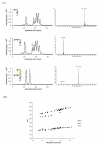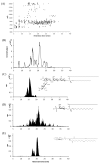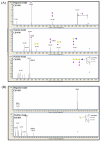Multiple precursor ion scanning of gangliosides and sulfatides with a reversed-phase microfluidic chip and quadrupole time-of-flight mass spectrometry
- PMID: 22697387
- PMCID: PMC3402638
- DOI: 10.1021/ac300254d
Multiple precursor ion scanning of gangliosides and sulfatides with a reversed-phase microfluidic chip and quadrupole time-of-flight mass spectrometry
Abstract
Precise profiling of polar lipids including gangliosides and sulfatides is a necessary step in understanding the diverse physiological role of these lipids. We have established an efficient method for the profiling of polar lipids using reversed-phase nano high-performance liquid chromatography microfluidic chip quadrupole time-of-flight mass spectrometry (nano-HPLC-chip Q-TOF/MS). A microfluidic chip design provides improved chromatographic performance, efficient separation, and stable nanospray while the advanced high-resolution mass spectrometer allowed for the identification of complex isobaric polar lipids such as NeuAc- and NeuGc-containing gangliosides. Lipid classes were identified based on the characteristic fragmentation product ions generated during data-dependent tandem mass spectrometry (MS/MS) experiments. Each class was monitored by a postprocessing precursor ion scan. Relatively simple quantitation and identification of intact ions was possible due to the reproducible retention times provided by the nano-HPLC chip. The method described in this paper was used to profile polar lipids from mouse brain, which was found to contain 17 gangliosides and 13 sulfatides. Types and linkages of the monosaccharides and their acetyl modifications were identified by low-energy collision-induced dissociation (CID) (40 V), and the type of sphingosine base was identified by higher energy CID (80 V). Accurate mass measurements and chromatography unveiled the degree of unsaturation and hydroxylation in the ceramide lipid tails.
Figures




Similar articles
-
Highly sensitive localization analysis of gangliosides and sulfatides including structural isomers in mouse cerebellum sections by combination of laser microdissection and hydrophilic interaction liquid chromatography/electrospray ionization mass spectrometry with theoretically expanded multiple reaction monitoring.Rapid Commun Mass Spectrom. 2010 Oct 30;24(20):2957-65. doi: 10.1002/rcm.4716. Rapid Commun Mass Spectrom. 2010. PMID: 20872628
-
An offline two-dimensional supercritical fluid chromatography × reversed phase liquid chromatography tandem quadrupole time-of-flight mass spectrometry system for comprehensive gangliosides profiling in swine brain extract.Talanta. 2020 Feb 1;208:120366. doi: 10.1016/j.talanta.2019.120366. Epub 2019 Sep 17. Talanta. 2020. PMID: 31816731
-
Structural characterization of monosialo-, disialo- and trisialo-gangliosides by negative ion AP-MALDI-QIT-TOF mass spectrometry with MS(n) switching.Neurochem Res. 2012 Jun;37(6):1315-24. doi: 10.1007/s11064-012-0735-z. Epub 2012 Mar 6. Neurochem Res. 2012. PMID: 22392257
-
Screening of synthetic PDE-5 inhibitors and their analogues as adulterants: analytical techniques and challenges.J Pharm Biomed Anal. 2014 Jan;87:176-90. doi: 10.1016/j.jpba.2013.04.037. Epub 2013 May 6. J Pharm Biomed Anal. 2014. PMID: 23721687 Review.
-
High-energy collision induced dissociation of biomolecules: MALDI-TOF/RTOF mass spectrometry in comparison to tandem sector mass spectrometry.Comb Chem High Throughput Screen. 2009 Feb;12(2):137-55. doi: 10.2174/138620709787315436. Comb Chem High Throughput Screen. 2009. PMID: 19199883 Review.
Cited by
-
Recent advances in the mass spectrometric analysis of glycosphingolipidome - A review.Anal Chim Acta. 2020 Oct 2;1132:134-155. doi: 10.1016/j.aca.2020.05.051. Epub 2020 May 24. Anal Chim Acta. 2020. PMID: 32980104 Free PMC article. Review.
-
Quantitation of human milk proteins and their glycoforms using multiple reaction monitoring (MRM).Anal Bioanal Chem. 2017 Jan;409(2):589-606. doi: 10.1007/s00216-016-0029-4. Epub 2016 Oct 29. Anal Bioanal Chem. 2017. PMID: 27796459 Free PMC article.
-
Application of industrial treatments to donor human milk: influence of pasteurization treatments, storage temperature, and time on human milk gangliosides.NPJ Sci Food. 2018 Mar 13;2:5. doi: 10.1038/s41538-018-0013-9. eCollection 2018. NPJ Sci Food. 2018. PMID: 31304255 Free PMC article.
-
Structural characterization of gangliosides and glycolipids via ultraviolet photodissociation mass spectrometry.Anal Chem. 2013 Nov 5;85(21):10399-407. doi: 10.1021/ac402379y. Epub 2013 Oct 21. Anal Chem. 2013. PMID: 24083420 Free PMC article.
-
Characterization of Glycosphingolipids and Their Diverse Lipid Forms through Two-Stage Matching of LC-MS/MS Spectra.Anal Chem. 2021 Feb 16;93(6):3154-3162. doi: 10.1021/acs.analchem.0c04542. Epub 2021 Feb 3. Anal Chem. 2021. PMID: 33534538 Free PMC article.
References
-
- German JB, Gillies LA, Smilowitz JT, Zivkovic AM, Watkins SM. Curr. Opin. Lipidol. 2007;18:66–71. - PubMed
-
- Wenk MR. Cell. 2010;143:888–895. - PubMed
-
- Rajendran L, Simons KJ. Cell Sci. 2005;118:1099–1102. - PubMed
-
- Jacobson K, Mouritsen OG, Anderson RG. Nat. Cell. Biol. 2007;9:7–14. - PubMed
-
- Di Paolo G, De Camilli P. Nature. 2006;443:651–657. - PubMed
Publication types
MeSH terms
Substances
Grants and funding
- P42 ES02710/ES/NIEHS NIH HHS/United States
- P01 ES011269/ES/NIEHS NIH HHS/United States
- R01 ES002710/ES/NIEHS NIH HHS/United States
- R01 HD061923/HD/NICHD NIH HHS/United States
- S10RR027639/RR/NCRR NIH HHS/United States
- R01 HD059127/HD/NICHD NIH HHS/United States
- P01 ES11269/ES/NIEHS NIH HHS/United States
- 1R01HD061923/HD/NICHD NIH HHS/United States
- R01 GM049077/GM/NIGMS NIH HHS/United States
- S10 RR027639/RR/NCRR NIH HHS/United States
- R37 ES002710/ES/NIEHS NIH HHS/United States
- 5R01HD059127/HD/NICHD NIH HHS/United States
LinkOut - more resources
Full Text Sources

